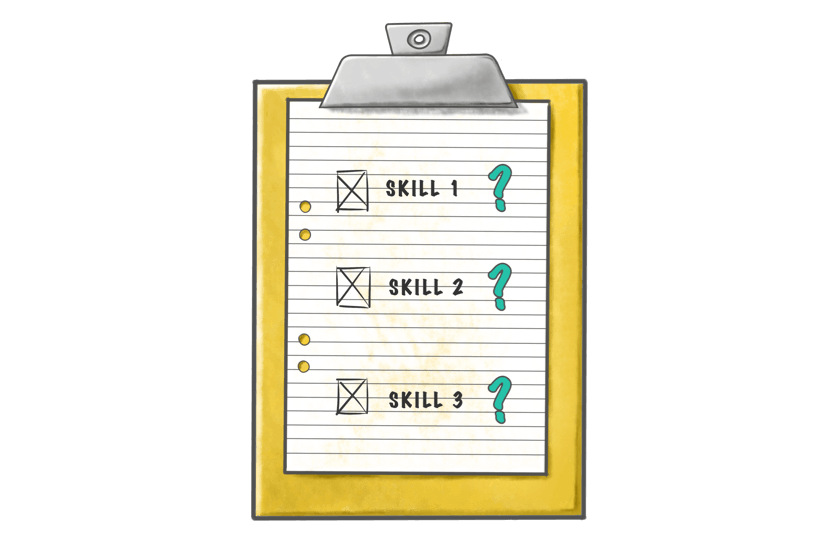
At Yarno, we like to call our microlearning modules 'campaigns' - so I describe our learning model as a ‘campaign-based’ approach.
"Hang on," you might say, "that doesn't make sense". The word 'campaign' is typically associated with marketing, rather than learning, but it turns out the two actually have quite a bit in common.
Have you heard about the marketing Rule of 7? It outlines that the average potential customer interacts with your brand seven times before making a purchase. Repetition is the key here. The same is true of any learning - the more times a learner interacts with the content, the likelier it is to stick in their long-term memory.
But the similarities don't end there!
A marketing campaign focuses on an objective, like driving sales of product X, and a desired result, like a return on the marketing spend. Well, news flash! When putting together your learning plan, you can follow a similar process to achieve your objectives.
According to i7 Marketing, there are 6 key components of any successful marketing campaign.
- Determine your objective and budget
- Identify your audience
- Create your message
- Develop your media strategy
- Implement the campaign
- Measure and analyse results
You’re probably thinking - sounds nothing like workplace learning. And, if you're thinking about traditional workplace learning, you're not wrong!
Traditional learning techniques, particularly workplace learning, are based on two types of learning moments: just-in-time and compliance-based. Just-in-time learning is centred around delivering learning at the time of need. For example, I need to bake a cake for my Bluey-obsessed 6-year-old’s birthday. So, I Google a tutorial on how to bake the Duck Cake from the Women’s Weekly Birthday Cake book. I watch the video, and then get up to my armpits in buttercream frosting.
Whilst just-in-time learning is amazing for this type of scenario, it also places the onus of learning on the individual. It also relies on the individual to understand they have a gap in their knowledge, and that they stand to benefit from increasing their knowledge of something.
Compliance-based training is generally one-and-done training, triggered by an event such as induction or the dreaded, “oh no, I have to sit through another hour training course on how to lift a box correctly”. We call this type of training “click-next compliance” because it usually involves the learner clicking furiously to progress to the end of the module (and not taking much of the content in!).
The flip side to just-in-time and compliance training is what we call campaign-based learning. This style of learning is a more structured way of delivering the same information, more strategically, through a series of engaging learning experiences that occur over time (we recommend a customer runs 8-10 campaigns per annum). The ultimate goal here is to embed information into long-term memory and create lasting behaviour change.
Rolling out learning in a campaign format means that you can schedule it, promote and communicate about it, collect and compare pre- and post-campaign data to accurately measure results, and more effectively target your team's learning needs going forward. Being in control of the content you're covering also means you can plan for it within annual training budgets (overspending habits die hard!).

What does a learning campaign look like?
At Yarno, we deliver two types of learning campaigns: bursts, and embed campaigns. We also recommend a customer uses a mix of these campaigns throughout the year to maximise the learning outcomes.
- Bursts are designed to deliver time-critical information in a short, sharp, targeted burst. Questions are delivered all in one go, so learners can get across the content quickly.
- Embed campaigns are designed to reinforce knowledge and improve learner performance throughout the campaign. They run over a number of weeks and questions repeat (via spaced repetition), giving the learner opportunity to address gaps in their learning and answer correctly the second time. Embed campaigns also rely heavily on the competition and gamification elements baked into Yarno’s system.
OK, so what does any of this have to do with running a marketing campaign? Let’s work through it.
1. Determine your objective and budget
When a brand decides to launch a new product, they have a brief with objectives and budgets. The first step in a marketing campaign is to identify what you want to achieve (for example, an increase in sales), and where it fits within the overall budget. The same is true for a learning campaign: the first step is figuring out exactly which metrics you are aiming to change with training, defining the learning goal, and making sure it fits within the budget.
At Yarno, we're big fans of Cathy Moore. Her template for determining the objective of any given learning is:
An identified metric will increase/decrease X% by [insert date] as people do ABC
For example, sales for a product will increase by 25% by the end of Q3, as people develop stronger customer service skills.
Following this framework allows a clear goal to be set that not only guides how the learning content is designed, but how to measure the success once the campaign has been completed.
2. Identify your audience
Who in your organisation will need to undergo training? Where can you target to best maximise the effectiveness of your training?
Similar to a marketing campaign, learning is most effective when it’s relevant to the target audience. You’re not going to deliver product knowledge on your latest range of shoes to your HR department - instead, it will be targeted to customer-facing staff, who need to be on top of the benefits of each shoe to help sell them to customers.
On the other hand, if you're looking to educate the entire company on a new leave policy, every staff member will likely need to undergo this training.
3. Create your message
What are the key messages you need to convey to achieve your objective?
Like focussing your marketing on the key benefits of a new product, a learning campaign should feature the key concepts you are trying to communicate with training, to achieve the desired behaviour change. Working backwards from what you’re trying to achieve is a great way to start.
Say you are aiming to increase your Net Promoter Score (NPS). What behaviour needs to change, and what knowledge and skills need to develop for this to happen? This will become your key messaging and will guide your learning content creation.
At Yarno, we run mind-mapping sessions for every new campaign we run for a customer. In these sessions, we’re aiming to extract the key bits of information we need to target with training in order to maximise the value of the learning, and to ensure the most effective experience for the learner.
4. Develop your media strategy
How are you communicating the learning campaign to your team?
In order to run your campaign smoothly, and see maximum participation and engagement, learners need to understand the process, why they’re being asked to participate, how it will impact their performance, and what business result the learning is targeting. Other elements to communicate would be around the competition side of the campaign - is there a prize? Is it team vs team, mate vs mate or state vs state for example.
It’s exciting - hype it up!
For example, if you’re targeting customer service skills in a 3 week campaign, let the learner know the campaign will involve daily questions for 3 weeks designed to improve their ability to help customers and make sales.
At Yarno, our Customer Team liaises with customers to develop a communication plan that is designed to suit their team. We bear in mind the level of digital literacy on the team, and how the company communicates internally. Our proposed comms plan details ways the team manager can communicate to their learners about Yarno: what Yarno is, what learners can expect, why the business is introducing Yarno and why it will be fun!Ways to communicate this might include digital posters for the intranet or printed collateral for the lunchroom. Simple things like this means that the campaign rollout will be much smoother, leading to higher participation, completion rates, and behaviour change across the board.
Below is an example of a digital poster that could be shared on the intranet or via email - addressing some of the main questions new learners might have.

5. Implement the campaign
This one should be pretty self-explanatory: your campaign rollout. Much the same as rolling out a marketing campaign, you are pushing live on all that preparation you’ve done, and watching the impact of all your hard work.
If you’re rolling out a Yarno campaign, you’ve worked with the content team to craft targeted learning questions/explanations, communicated to your team that the campaign is live, and they can go forth and learn!
Pushing the campaign live is the big step, and luckily by this stage you’ve got excited learners and a strong understanding of which business metrics you’re targeting. From here, you can just sit back and watch the results roll in.
6. Measure and analyse results
Phew, the campaign is done! Pat yourself on the back, you’ve done a great job - but you’re not quite finished yet.
Once a marketing campaign has been rolled out, it is measured against its objectives to make sure the campaign was successful. Suddenly, pre- and post-campaign data is really powerful. By comparing these data sets, you can see whether your campaign impacted the statistic you were targeting. The same is true of your learning campaign.
Yarno allows training managers to see data and insights such as a learner's question performance including weakest and strongest topic areas. These are great if you are looking to understand knowledge gaps and how this could impact certain behaviours in the workplace. So if, for example, you were aiming to reduce customer complaints in your call centre, and the weaker topic areas from your most recent campaigns were “actively listening” and “delighting the customer” (aka two key areas identified as helping to reduce complaints) – you can now focus future learning or coaching around those two areas. Sometimes, the solution could be as simple as rolling out another Yarno campaign on these two topics to embed and reinforce these key areas.
Wrap up
And there you have it!
In a nutshell: approaching workplace learning like a marketing campaign is a highly effective way to get maximum buy-in and engagement (completion rates), embed knowledge, and measure the effectiveness of your learning!
Future training becomes super targeted, and you're getting the most bang for your learning buck. And as a bonus, you have the data to back it up and demonstrate to your business that you're addressing the business need! Win-win!













































































































